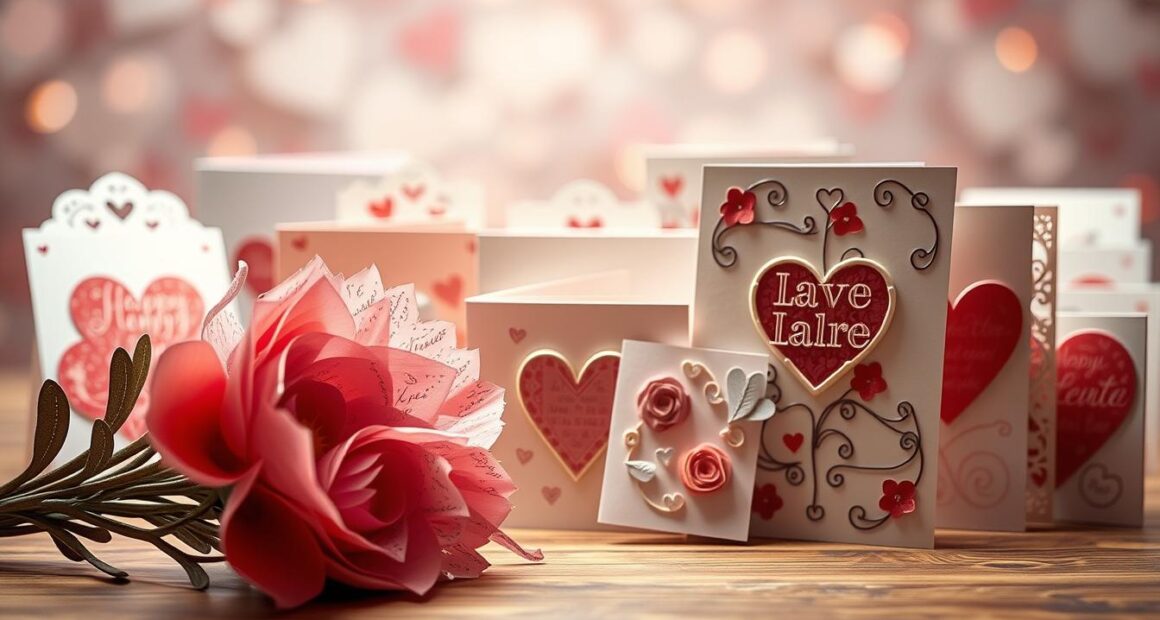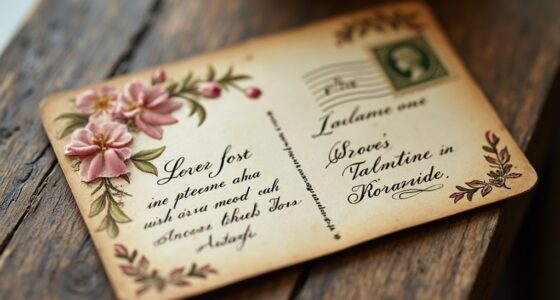As Valentine’s Day approaches, there’s a special magic in the air, isn’t there? You can feel it—the excitement of expressing your feelings is palpable, and the thought of crafting a card that truly represents your love and appreciation for someone close to you is a beautiful journey. Take a moment and reflect on the last time you received a handmade card. The effort, creativity, and personal touches left a lasting impression, didn’t they? With Valentine’s Day spending expected to reach approximately $23.9 billion this year, it’s clear that card exchanges continue to hold a cherished place in our celebrations. This year, why not elevate your gestures? Creating unique Valentine’s Day card designs allows you to foster your creativity and connect more deeply with your loved ones. Whether it’s DIY valentine cards brimming with personal flair or a heartfelt message, infusing a piece of yourself into each card can transform a simple token into a treasured keepsake.
With 31% of people planning to create DIY gifts in 2023, the trend towards personalization not only reflects creativity but also strengthens relationships. Unique valentine’s cards with hand-drawn elements or crafted messages can evoke those warm feelings that store-bought options often miss. Let’s explore how to embark on this enchanting journey of card-making together, so you can leave a lasting impact on the ones you love.
Key Takeaways
- Creating personalized cards enhances emotional connections.
- DIY valentine cards are a growing trend, with many opting for unique designs.
- Valentine’s Day spending shows the continued importance of card exchanges.
- Personal touches in cards can significantly increase their emotional impact.
- Craft supplies see a noticeable rise in sales leading up to Valentine’s Day.
- Homemade gifts are preferred by a large percentage of consumers.
- The journey of creating cards can be as fulfilling as the final product itself.
Why Personalizing Your Valentine’s Day Card Matters
Creating personalized valentine’s day cards adds a special touch that elevates the entire experience for the sender and the recipient. Unique cards that feature heartfelt messages or personal artwork can foster significant emotional connections, setting your card apart from mass-produced options. In a world filled with generic choices, a thoughtfully designed card communicates your care and effort.
The Impact of Personalized Touches
Adding a personal handwritten message to your card can dramatically enhance its emotional value. This small gesture distinguishes your card from others relying solely on printed messages. Consider incorporating a love letter or poem, transforming a simple card into a cherished keepsake. You might also explore love tokens, such as promises for future date nights or humorous elements that express your relationship’s playful side.
Creating Emotional Connections
Including a memorable photo can significantly boost emotional engagement. Remember, “a picture is worth a thousand words,” and this element can amplify the sentiment behind your unique cards. Fun sketches and playful stickers further enhance the card’s personality, making it feel more thoughtful and personal. As a creative idea, a DIY project like the “Reasons Why I Love You” heart paper chain can add value, expressing deep feelings while serving as a keepsake.
Standing Out in a Sea of Cards
In 2020, Americans spent around $1.3 billion on Valentine’s Day cards, highlighting the vast array of options available. Personalizing these cards becomes crucial to standing out in such a saturated market. Adding romantic quotes, referencing meaningful love stories, and sprinkling heart-shaped confetti inside can create delightful surprises. Don’t forget envelope embellishments, such as ribbons or hand-drawn designs, which enhance thoughtfulness even before the card is opened.

| Personalization Techniques | Emotional Impact | Creative Ideas |
|---|---|---|
| Handwritten Messages | Deepens emotional connections | Love letters, poems |
| Incorporating Photos | Increases emotional engagement | Memorable snapshots |
| Fun Sketches and Stickers | Conveys thoughtfulness | Personal drawings, humorous stickers |
| Creative DIY Elements | Enhances card value | Heart paper chains, love tokens |
Popular Themes for Valentine’s Day Card Designs
As Valentine’s Day approaches, many people explore different themes to express their feelings. Card designs have evolved, reflecting a blend of emotions and creativity. Incorporating various themes helps create cards that resonate with recipients, making the experience more meaningful.
Romantic Themes
When it comes to romantic card ideas, designs often feature hearts, roses, and messages of love. The use of soft colors and elegant fonts can enhance the romantic vibe. For instance, Rifle Paper Co. offers the Rouge Valentine’s Day Card priced at $6, showcasing a beautiful aesthetic that appeals to couples seeking something sentimental.
Humorous Themes
Humorous valentine cards can add a playful touch to the occasion. Cards that incorporate puns or funny illustrations, such as the AmeliaEllwood You Croc My World Card priced at $5, are perfect for friends and loved ones. These light-hearted designs foster laughter and joy while conveying affection, making them popular choices for those looking to bring a smile to someone’s face.
Friendship and Appreciation Themes
Friendship appreciation cards emphasize gratitude and the significance of all relationships. You can celebrate these connections with thoughtful messages tailored for friends and family. Cute options like the WunderkidArt Sending You Warm Hugs Card priced at $10 show how appreciation can transcend beyond romantic gestures and foster connections among friends.

Choosing the Right Card Size and Format
Selecting the appropriate card size and format greatly influences your Valentine’s Day card’s overall impact. A thoughtful choice ensures that your card stands out and effectively communicates your message. Understanding the differences in card sizes, along with popular formats, can help you make the best decision for your design.
Traditional vs. Modern Card Sizes
Traditional card sizes continue to be popular, with the classic 5×7-inch and 4×6-inch formats frequently used. These standard sizes fit common envelopes, making mailing straightforward. On the other hand, modern or custom card sizes can provide a unique twist. For example, a 12×12-inch cardstock creates an impressive canvas for creative expressions. The Heart Accordion card, made from a 5 1/2×12-inch rectangle, transforms into six sections when folded, offering an innovative folding technique that adds height to your card.
Folded Cards vs. Postcards
When exploring card formats, you can choose between folded cards and postcards. Folded cards provide ample space for personal messages and a more formal presentation. This allows for creativity, as you can include embellishments like stickers, ribbons, or other materials. Postcards, on the other hand, are straightforward and simple to send, making them ideal for quick greetings. They convey messages directly on the front, combining convenience with personal touch.
Digital Card Options
Digital Valentine cards have gained popularity, particularly for their convenience and instant delivery. These cards can be customized easily, allowing you to add personal touches without the constraints of physical materials. You can design your digital cards using tools such as Canva, which provides numerous fonts and templates. Sending these cards via email or sharing them on social media enables you to reach a broader audience swiftly, meeting the demands of modern communication.

| Card Type | Size Options | Best For |
|---|---|---|
| Folded Cards | 5×7 inches, 4×6 inches | Personal messages, embellishments |
| Postcards | Standard postcard size | Quick greetings, straightforward delivery |
| Digital Cards | Customizable sizes | Convenience, social media sharing |
Essential Tools for Designing Your Card
Creating a unique Valentine’s Day card involves using a variety of tools to help bring your ideas to life. Whether you prefer digital designs or crafting by hand, having the right resources at your disposal makes a significant difference in the final product. Here are some essential tools you can utilize for your card creation journey.
Graphic Design Software
Graphic design software like Adobe Illustrator and Canva plays a crucial role in modern card design. These platforms provide a customizable digital canvas, allowing for intricate illustrations, text placements, and personalized templates. You can experiment with different color palettes, such as the vibrant shades of the ‘Cupid’s Kiss’ palette, to create eye-catching designs that attract attention and evoke emotion.
Online Card Makers
If you’re looking to simplify the design process, online card makers offer user-friendly templates that require little to no design experience. These tools allow you to add personal touches while selecting from a range of pre-made designs. You can make your card special without hours of technical work, ensuring that even last-minute creations maintain a unique charm.
Craft Supplies for Handmade Cards
For those who appreciate a hands-on approach, having quality handmade card supplies is essential. Gather items like glue, card stock, scissors, and embellishments such as stickers and ribbons. Utilizing these handmade card supplies can lead to a crafted piece that reflects your creativity and personal touch, resonating well with recipients. Mixing different textures and materials provides an added dimension that enhances the overall look and feel of your cards.

Color Schemes That Spark Joy
Choosing the right color schemes plays a vital role in the impact of your Valentine’s Day card. By selecting classic valentine colors like red, pink, and white, you evoke feelings of love and affection. Expanding beyond these traditional hues can lead to creative card designs that capture attention through innovative combinations. Let’s explore some vibrant options that bring life to your designs.
Classic Valentine’s Day Colors
Classic valentine colors remain timeless and effective, conveying deep emotions associated with love. The most common palette includes:
- Deep Red
- Soft Pink
- Pure White
These colors effectively communicate romance and tenderness, making them perfect for any Valentine’s Day message.
Innovative Color Combinations
For a fresh take, consider using innovative color combinations that create striking contrasts. Here are a few suggestions:
- Lavender, Gold, and Cream
- Teal, Coral, and Navy
- Mustard, Eggplant, and Soft Gray
These options allow your designs to stand out, turning simple cards into captivating visual pieces.
Using Patterns and Textures
Textures and patterns enrich your card’s visual appeal, adding a tactile element that enhances creativity. Techniques such as:
- Stamped designs
- Embossed elements
- Layered papercraft
Using these methods gives depth to your work while ensuring the color schemes resonate well with your intended message.

Selecting the Perfect Font Styles
Choosing the right font styles can significantly enhance the aesthetic of your Valentine’s Day card. The typeface you select communicates a tone, emotion, and intention. Different fonts evoke distinct feelings, which makes understanding your options crucial for creating the perfect card.
Romantic Script Fonts
Romantic fonts convey elegance and warmth, adding a personal touch to your heartfelt messages. Many designs feature flowing letters reminiscent of calligraphy, transforming even the simplest phrases into expressions of love. Heart fonts, particularly popular in 2025, directly connect to romance, making them ideal for Valentine’s Day greetings and weddings.
Bold and Playful Fonts
If you’re aiming for a lively vibe, bold and playful fonts work wonders. These fun font pairings are perfect for humorous cards or lighthearted acknowledgments. The visual impact of thick strokes ensures that your message stands out, capturing attention and creating a joyful atmosphere for recipients.
Font Pairing Tips
Pairing different font styles can enhance the visual appeal of your card. Combining a romantic script font with a clean sans-serif typeface creates contrast and maintains readability. Aim for a mix of decorative styles that maintain legibility while aligning with the emotional intent of your message. Integrating heart shapes or playful elements into letters can further tie your design to the romantic themes. Consider these pairings:
| Font Style 1 | Font Style 2 | Use Case |
|---|---|---|
| Heart Script | Clean Sans-Serif | Romantic Greeting Cards |
| Playful Brush Font | Modern Sans-Serif | Humorous Messages |
| Elegant Cursive | Simple Serif | Wedding Invitations |
| Bold Display Font | Minimalist Sans-Serif | Friendship Cards |

Adding Meaningful Messages and Quotes
Creating a Valentine’s Day card becomes even more special when you include thoughtful words. Meaningful messages transform a simple card into a cherished keepsake. Personalizing your card with heartfelt expressions helps convey genuine feelings, while integrating famous love quotes can elevate the emotional weight of your message.
Crafting Your Own Messages
When you take time to craft your own messages, you infuse the card with your personality and emotions. Consider what makes your relationship unique. Reflect on shared moments and inside jokes that speak to your connection. By expressing your thoughts authentically, you enhance the emotional bond that can strengthen ties between you and your loved one.
Using Famous Love Quotes
Famous love quotes have a rich history of resonating with people. Including a poignant quote can amplify your feelings and connector to larger stories of love. Think of quotes that not only sound beautiful but also encapsulate your sentiments perfectly. This creative touch can add depth to your card, making it even more impactful.
Tips for Writing Heartfelt Messages
To craft truly heartfelt messages, focus on sincerity and reflection. Tailor your words to fit the recipient’s personality and your relationship dynamics. Simple gestures, such as mentioning why you appreciate them or recalling a fond memory, create strong emotional resonance. Remember, a handwritten note carries much greater significance than a digital message. This effort demonstrates thoughtfulness and shows your love in a tangible, lasting way.

Incorporating Personal Photos and Artwork
Creating a Valentine’s Day card that reflects your unique style can elevate your heartfelt message. By incorporating personal photos and original artwork, you fashion a truly special card that resonates with the recipient. This section covers how to best utilize your own artwork, select memorable photographs, and address essential privacy considerations.
How to Use Your Own Artwork
Drawing from your creativity can give the card an authentic touch. Original artwork, such as watercolor hearts or nostalgic illustrations, can convey emotional depth. Techniques like ombré hearts or floral designs can beautify your card while showcasing your artistic flair. If drawing isn’t your strength, explore collage methods that allow you to combine various materials for a vibrant representation of love.
Tips for Selecting Photos
Personal photos can evoke warm memories and enhance the sentimentality of your card. Choose high-quality images that reflect your relationship. They could be snapshots from a memorable date or a silly selfie that brings laughter. Ensure each photo fits seamlessly into the card’s layout, maintaining a cohesive aesthetic. Think about the emotions each image represents, as it will add meaning to the card.
Privacy Considerations
Respecting privacy in card designs is paramount, especially when sharing pictures digitally. Always consider the feelings and consent of those featured in your personal photos. This ensures everyone involved feels comfortable with their image being used. You can keep some elements private—like inside jokes or personal memories—while still sharing the card publicly. Striking a balance between creativity and privacy is crucial.

Creative Ideas for Incorporation
- Heart Photo Collage: Create a collage of cherished moments.
- Watercolor Techniques: Utilize different styles like the Floral Heart to personalize your card.
- Pop-Up Elements: Add a 3D heart for an interactive surprise.
- Minimalist Designs: Embrace simplicity with a Single Line Drawing.
Using personal touches such as personal photos and original artwork can make your Valentine’s card stand out, making it not just a gift, but a treasured keepsake for years to come.
Enhancing Your Card with Embellishments
Incorporating card embellishments elevates the overall look and feel of your Valentine’s Day card. By adding stickers, ribbons, and unique textures, you create a multi-dimensional appeal that captures attention. Whether you choose handmade or digital enhancements, each element fosters personalization that resonates with recipients.
Stickers and Adhesives
Stickers bring a playful element to cards, allowing you to express creativity effortlessly. From heart-shaped stickers to whimsical characters, the possibilities are endless. Adhesives play a critical role, ensuring everything stays in place while adding layers of interest. Many DIY card makers report using materials they already have at home, making stickers an economical embellishment option.
Ribbons and Textures
Ribbons offer a classic touch, enhancing both the visual appeal and the tactile experience of your card. Utilizing textured embellishments significantly boosts a card’s attractiveness; these cards are perceived as 60% more appealing than their flat counterparts. Craft enthusiasts often experiment with up to five different textures to create unique looks, showcasing their skills and personal style.
Digital Embellishment Options
The rise of digital enhancements has transformed the way cards are designed. You can use software and online tools to add artistic elements without the mess of physical materials. Online tutorials have surged in popularity, reflecting a strong interest in integrating technology into crafting. This modern approach provides flexibility for various skill levels, ensuring everyone can contribute to the DIY card revolution.

| Embellishment Type | Benefits | Popularity |
|---|---|---|
| Stickers | Ease of use, affordable | 75% of DIY card makers prefer |
| Ribbons | Elegant, versatile | 60% of makers use in designs |
| Textured Embellishments | Increases appeal, tactile | 60% prefer textured over flat |
| Digital Enhancements | Convenient, mess-free | 50% rise in tool usage |
Each embellishment type offers unique advantages, contributing to a card that showcases your creativity and thoughtfulness. Explore various styles and techniques to find the perfect combination for your Valentine’s Day card, captivating your loved ones with personalized flair.
Printing Options for Your Card
When it comes to bringing your Valentine’s Day card designs to life, the printing options you choose play a crucial role. Selecting the right card paper options affects both the durability and aesthetics of your card. With various finishes available, you can create a card that truly stands out.
Choosing the Right Paper
Your choice of paper can transform your card from a mere concept to a beautiful keepsake. Options often include:
- Glossy for vibrant images
- Matte for a sophisticated touch
- Textured finishes for added depth
- Premium cardstock for a luxurious feel
Consider special trims like round or elegant, which provide added flair, especially with premium cardstock. Be mindful that some trims are not available for Same Day Pickup.
Local vs. Online Printing Services
You have the option to choose between local and online printing services. Local shops often deliver a personal touch with on-site consultations. Online services, like Walgreens, offer convenience and speed with features like “Mail-for-Me” cards that can be sent directly to recipients. Both services typically provide detailed descriptions of their card options, facilitating easy decision-making.
Eco-Friendly Printing Choices
Choosing eco-friendly printing ensures that your beautiful card design aligns with sustainable practices. Many services now offer:
- Sustainable papers made from recycled materials
- Non-toxic inks for safer printing
This option allows you to convey your love while being mindful of the environment, making your card not just a message of affection but a statement of care for our planet.

Sending Your Card: Timing and Methods
Understanding how to effectively send your Valentine’s Day card can enhance the entire gifting experience. With Valentine’s Day falling on February 14th, timing plays a crucial role in ensuring that your heartfelt sentiments reach their destination on time. Knowing the best practices for mailing cards, utilizing last-minute delivery options, and exploring personalized sending methods can help you navigate the process smoothly.
Best Practices for Mailing Cards
To ensure your mailing cards arrive promptly, consider these best practices:
- Address your envelopes clearly, including both the recipient’s and your return address.
- Consider the weight of your card; heavier cards may require additional postage.
- Mail your cards a few days in advance, particularly as Valentine’s Day approaches, to account for any potential delays.
Digital Delivery for Last-Minute Shoppers
For those who find themselves pressed for time, digital delivery serves as an effective solution. Sending an e-card can be just as meaningful as a physical card, with many services allowing for customization. This approach guarantees your message arrives instantly, making it ideal for last-minute delivery.
Personalized Delivery Ideas
To make your sending methods even more special, consider personalized delivery approaches. Here are some creative ideas:
- Leave the card on your partner’s car for a delightful surprise.
- Add a small gift to accompany your card for a more memorable experience.
- Use mailboxes or a friend’s help to secretly deliver the card at an unexpected time.

Unique Ideas for Surprise Card Recipients
When it comes to surprising your loved ones with Valentine’s Day cards, think outside the box. Unique approaches can elevate traditional card giving into an experience filled with joy. From hidden messages to group card ideas, your creative endeavors can leave a lasting impression.
Hidden Messages and Surprise Elements
Incorporating surprise elements transforms an ordinary card into an extraordinary treasure. Hidden messages can create excitement, leading recipients to discover heartfelt notes. You might include small notes tucked inside or employ clever folding techniques to reveal messages. These elements not only enhance the emotional connection but make the process of opening the card a delightful experience.
Creative Card Reveal Techniques
Utilizing creative reveals engages the recipient further. Consider pop-up elements that spring to life when the card opens. You can also design cards that require a series of clues to unlock the final message. These interactive techniques will make your card memorable and emphasize the thoughtfulness behind your gesture.
Group Cards for Shared Love
Group card ideas offer a unique way for multiple friends or family members to express their affection collectively. Each person can contribute a piece of the design or add their messages, capturing a broad spectrum of love in one card. This collaborative effort not only strengthens bonds but also amplifies the joy experienced by the recipient, showcasing the shared sentiments of everyone involved.

| Aspect | Details |
|---|---|
| Surprise Elements | Hidden messages, pop-up features, clues for reveals |
| Creative Reveals | Interactive designs that enhance the experience |
| Group Card Ideas | Collaborative designs capturing shared affection |
| Popularity of DIY | 75% prefer receiving DIY gifts for their sentiments |
| Emotional Value | 67% believe handmade cards offer a personal touch |
Inspiring Examples of Valentine’s Day Card Designs
When it comes to card design examples, the realm of Valentine’s Day cards offers an abundance of creativity and inspiration. Handmade card inspiration can feature a range of styles from intricately crafted pop-ups to witty phrases that make recipients smile. For instance, humorous cards with sayings like “You’re My Favorite Blanket Stealer” or “I Love You Like a Back-Alley Hooker Loves Crack” showcase how laughter can become a heartfelt element in card giving.
Handmade Card Inspirations
Crafting your own cards can make the occasion even more special. Many DIY enthusiasts are opting for personalized designs using eco-friendly materials. Cards made from 100% post-consumer recycled materials combined with hand-printed illustrations using archival inks indicate a growing trend toward sustainability. The average size of these handmade cards, like the standard 10cm by 15cm, is perfect for creativity without overwhelming the recipient.
Digital Designs to Consider
If you’re more inclined towards digital options, there’s a myriad of appealing templates available online that cater to various themes, including romantic and humorous designs. These digital card ideas often include customization features, allowing you to add personal messages or photos, which can resonate well with over 35% of individuals preferring to customize their cards. Moreover, special effects like 3D glasses can take your card to the next level, capturing the essence of fun and surprise.
Real-life Success Stories
Don’t underestimate the power of thoughtfulness in card making—many real-life success stories illustrate how a unique card can enhance relationships. From couples exchanging cards to express their affection to friends sharing laugh-out-loud jokes, each card acts as a tiny love note that connects hearts. With the rise of DIY card trends, an impressive 23% increase in Pinterest searches shows a growing community embracing this personalized approach to celebrating love and friendship.









